In the first part of the 1990’s I spent a lot of time having a lot of fun with a band called The Rockingbirds. Their debut record – which we released on Heavenly in ’92 and re-released in 2008 – has more than stood the test of time and I don’t need a drink inside of me to tell anyone who will listen that it’s a stone cold classic (though beware if I have, I’ll tell you twice). We were all very close back then and my memories of that time are treasured.
Just recently, word reached me that the band had reformed and that singer/ songwriter Alan Tyler was even writing new material for some forthcoming shows. Not only that but he was also about to embark on a solo walk along the Norfolk coastline. This has to be documented, I thought, so I gave Alan a ring.
Thankfully I knew that Alan was a reader of Caught by the River and I didn’t have to go through a “Hi Alan, I’m doing this website with Robin and Andrew, it’s kinda like a magazine, well maybe a fanzine… fishing, books, walking, trees, birds, records, you know..”. I suggested he might like to write us a piece about his walk. “Love to” he replied.
Two weeks later, walk completed and notebooks transcribed, Alan sent me the piece. “I hope it’s what you had in mind, it might be a bit long…”. Alan had become a travel writer and much as I enjoyed reading it, it would have taken us at least six months to run the story of the nine-day trek. So, Alan has published it on his own blog and today we are posting ‘Day One’. If you wish to continue with Alan on his journey, you can find your way by clicking HERE.
And as for The Rockingbirds, they are next in action at The Luminaire in Kilburn, London NW6 on Saturday September the 4th. Hope to see you there. (JB)
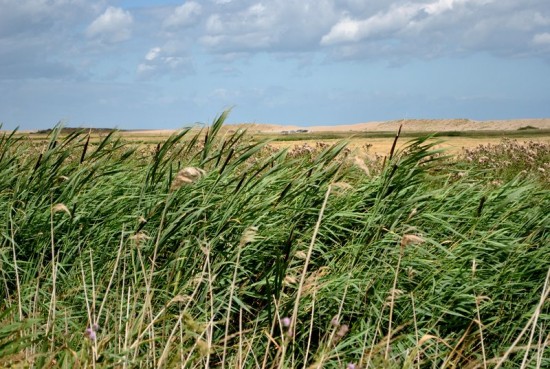
Walking the North Norfolk Coastal Path – July 2010 by Alan Tyler.
Day 1: Cromer to West Runton
I made it to Stratford. My overstuffed 65 litre second-hand rucksack has stayed intact – no pinging straps, no disheartening dull rips in the material, all the way along the 15 minute walk from my E15 flat in Windmill Lane across the Angel Lane Bridge to Stratford Railway Station.
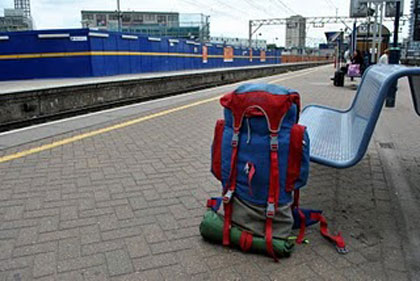
My plan today is to get to Norwich and then Cromer on the train, eat, then make the mile or so walk going west along the start of the 47 mile North Norfolk Coastal Path to my first campsite in East Runton. This walk will give me some indication of how robust and manageable my load is going to be for the rest of the 47 miles, to be completed in admittedly fairly moderate stages over nine days. At this point I don’t know whether I, nor the pack, are up to it. The weather is overcast and comfortably warm which suits me. No sign of the predicted rain – that will come…
Having decided a month or so ago to do a long camping hike somewhere across East Anglia, I have spent a fair bit of time first deciding where to go, and then working out how to do it. The Suffolk Coastal Path (Felixstowe to Lowestoft), and The Essex Way (my doorstep to Harwich) were also considered, as was “wild” camping in a bivvi bag, but North Norfolk was chosen because it has more in the way of “tame” camping locations for this entry level hiker, as well as an abundance of landscape and places of interest at least as inspiring as any offered by the other eastern destinations. There is also the appeal of going back to places last visited on dreamily remembered happy holidays over 40 years ago.
Waiting on the platform at Stratford I remember I have nothing to read. Reading material was a first casualty when trying to reduce my load to something my rucksack can contain and I can carry. After protracted consideration, I had arrived at a list of “Things to take to Norfolk”. Here it is in all it‘s prosaic glory:
65 Litre rucksack
1 man tent
Sleeping bag
Inflatable sleeping mat and inflatable pillow
Sharp knife, plastic knife, fork and spoon
Mess tin
Scourer
Burner and gas
Needle and thread, thimble, small scissors
Thin folder with basic map and travel info (campsites, booking confirmations etc)
Small torch
Wallet, keys, cards, money
Sunscreen
Insect repellent
Plasters
Small lump of soap
Toothbrush and tube of (almost empty) toothpaste
Hat
Shoes
Swimming shorts
Sarong (makes for a towel and a blanket)
Socks (1 spare pair)
Pants (1 spare pair)
Shirt (1 spare)
Spare trousers/shorts
Waterproof jacket
Fleece
Jumper
Water bottle
Food (nuts, fruit, dry soup, porridge)
Tea (+ powdered milk and sugar lumps)
Smokes
Reading glasses
Notebook
Retractable pencil
Pen
DSLR camera
Camera charger
Mobile
Mobile charger
Everything goes in the rucksack or my pockets, except for the camera, which I will carry strapped round me in its carry case.
The 10.38 to Norwich comes in on time, passing through Chelmsford (“Home of Anglia Ruskin University” says the sign – must admit I’ve never heard of it), Colchester (“More than Britain’s oldest recorded town”), Manningtree (the station bar – “fine ales, good company” – looks decent), then a glimpse of the Portman Road football ground at Ipswich and on through Stowmarket and Diss to Norwich. Changing there for the Bittern Line train that takes me to Cromer, I chat to a cheery old Norfolk boy who sits opposite me. Maurice started his life in Norwich but for the last 30 years has lived in the Worstead, a few stops along the line. He did his national service in the early 50s with the RAF a few miles north on The Wash, which makes him in his late 70s. I tell him about my plan to walk the coastal path and he’s full of interest and suggestions, delighted to have someone new to talk to. Indeed it is nice for me to find the first local I meet so friendly and agreeable. The term “old boy” describes Maurice well – the wide eyed Norfolk lad in him shines through inevitably aged and withered features. As he skips off the train he advances the idea that we might meet again, “you never know!” There seems no need to dismiss the likelihood of this, just because I won’t be passing through Norwich or Worstead again on this trip.
Passing through Salhouse, Hoveton & Wroxham, Worstead, North Walsham, Gunton and Roughton Road, I arrive at Cromer (“gem of the Norfolk coast”) and trundle down the hill towards the front, where at about two o’clock I treat myself to fish and chips at the Regency Restaurant by the pier. I begin along the coastal path which goes up the promenade and then appears to terminate a little way up the cliff by the bowling green. Assuming (I think probably wrongly) that the path to East Runton must now follow the A149 (the main road that threads through all the towns and villages along this stretch of coast) I decide to take this course, which goes past Leakes Caravan Park, a place I stayed at as a small child, through East Runton village, and then to the grassy cliff top camp site of Woodhill Park.
I walk into the site office and I’m greeted in stereo by two smart ladies (one young, one not so young) sitting behind computer keyboards at a reception desk. I’m asked by one of them if I’ve had a good journey, and saying I have, I tell her my name, and she looks up my booking details. On the wall behind is a year by year succession of English Tourist Board holiday park awards going back to 1999. My receptionist again asks me if I’ve had a good journey and I repeat the reply I made just a few moments ago. Then the location of my pitch is carefully explained to me, with reference to a map of the site which is given to me along with an information sheet and rules of the camp. Off I go.
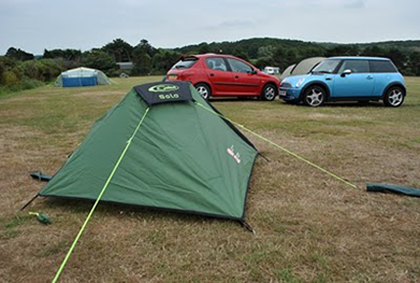
The site is pretty quiet, nobody much about except two men in green Woodhill Park polo shirts on their knees carefully re-painting the numbers on the concrete pitch markers with yellow paint. I nearly say “you could get the kids to do that” and then think better of it, not wishing to seem to mock their endeavour. There aren’t many tents about but my pitch is near two others. I’m amused by the super-abundance of rabbits on the site, grazing on the lawn and hopping in and out of the hedges. Pitching my lightweight solo tent is made poignant by the sound of muted shagging coming from inside the next tent along. This is interrupted twice by the sound of a mobile phone going off; after the first time it carries on, after the second the noises cease. Wriggling with difficulty into my small coffin shaped shelter, like some cryonic freezer compartment, I consider the implausibility of any “back to mine” action in the course of this trip.
Yesterday’s “West Runton here I come” Facebook posting had attracted an invitation from my friend Robert Dellar to go and visit his mum and dad who live in the village. I know Robert from writing fanzines in my youth and he’s worked for years for people with mental health problems, working for Southwark Mind and organising “Mad Pride” events. Lately he’s been campaigning on a “Back to work? No chance!” platform; defending benefits rights for the mentally ill. Not really able to tell whether his invitation is frivolous, mischievous or what, I decide to call his bluff and give it a go. People don’t knock on strangers’ doors and introduce themselves often enough, do they? Going up a hill and over West Runton Common I compose in my head a few words of introduction to say on the doorstep when I arrive.
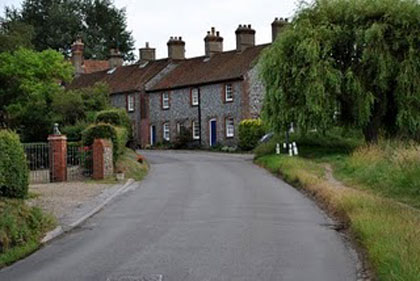
Finding the bungalow I ring the bell a little nervously and a blonde haired woman comes to the door. I start my introduction mentioning Robert, but perceiving confusion and alarm in her face the thought flashes through my mind that she thinks I may be here to impart some tragic news about her sometimes errant son. I quickly change my script; “don’t worry; there’s nothing to worry about”. Her husband appears at the door, the moment calms and I’m invited in by Pat and Reg. In their front room we get to the bottom (roughly) of who each of us are over tea and defrosted cream doughnuts. Reg talks about himself and his brother, veteran music journalist Fred Dellar, who began writing about jazz in the 50’s with his involvement in the Frank Sinatra fan club.
Wanting to explore the area, I decline kind offers of an evening meal and even a bed for the night and get on my way. I carry on up the road through woods towards a place called Beacon Hill, also known as Roman Camp (erroneously because it’s nothing of the sort); at 103 metres above sea level this is the highest point in Norfolk. Nearing the top I come to a crossroads and see signs that tell me I’ve reached the North Norfolk Coast Path. Evidently the path had earlier cut inland without me noticing where. As I’ll be coming back this way tomorrow I head back down the hill to West Runton.
I have no map; a serious omission perhaps. The only map I’ve taken with me on this trip is a fairly rudimentary one printed off the internet, which lacks any clear navigational detail. I had half heartedly thought I might get something more detailed when I got up here, but I’ve vaguely reasoned, rightly or wrongly, that if I stay in sight of the sea and keep going west I can’t go far wrong. The whole of the coastal path extends across three separate OS maps, and I’m not going to buy or carry around all those, much as I would like to have them. Similarly the full blown Norfolk coast path guide book I’d seen on Amazon would add to the bulk of the pack that I have wanted to ruthlessly reduce.
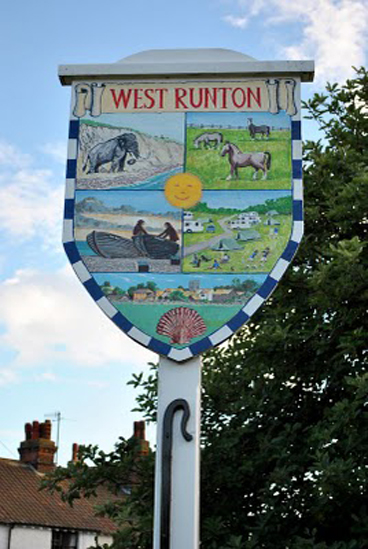
Crossing the lovely West Runton Common again I have a pint at the Village Inn, at the back of which used to be the West Runton Pavilion, now replaced by flats. A blue plaque on the wall of the pub says:
“WEST RUNTON PAVILION
Hosted concerts by legendary pop, rock and
punk artists from Chuck Berry, T-Rex and
Black Sabbath to the Sex Pistols and the
Clash, before it’s demolition in 1986.”
Looking around the quiet village of West Runton, with its charming flint built houses and cottages and sleepy rural ambience, it’s hard to imagine that this was the location of Norfolk’s illustrious rock venue. Kids from the surrounding area, Norwich and beyond (including my Norfolk based Rockingbirds brethren) would get the train here to see their favourite bands – at one time the venue even laid on coaches to and from different Norfolk desinations. You just wonder how many of the local residents bothered to look in.
Finishing my pint I walk down the lane beside the pub towards the cliffs and West Runton beach, where about 20 years ago, while my old band was doing gigs in the pubs of Camden, the skeleton of a 4 metre high mammoth, now known as the West Runton Elephant, was being dug out of the crumbling cliffs. The mammoth lived 700,000 years ago when the area was a wetland like the Norfolk Broads. A picture of the West Runton Elephant features proudly in a section of the coat of arms on the village green. It does not, unfortunately, include a picture of Marc Bolan or Johnny Rotten. I walk along the beach for a while in perfect summer sunshine, and then sit atop a cliff for half an hour, watching the sun set.